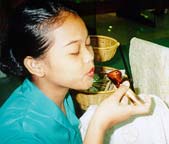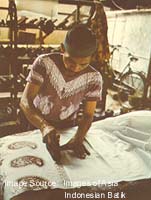Although the art form of batik is very intricate, the tools that are used are still very simple. The canting, believed to be a purely Javanese invention, is a small thin wall spouted copper container (sometimes called a wax pen) that is connected to a short bamboo handle. Normally it is approximately 11 cm. in length. The copper container is filled with melted wax and the artisan then uses the canting to draw the design on the cloth.
Canting have different sizes of spouts (numbered to correspond to the size) to achieve varied design effects. The spout can vary from 1 mm in diameter for very fine detailed work to wider spouts used to fill in large design areas. Dots and parallel lines may be drawn with canting that have up to 9 spouts. Sometimes a wad of cotton is fastened over the mouth of the canting or attached to a stick that acts as a brush to fill in very large areas.
Wajan
 The wajan is the container that holds the melted wax. It looks like a small wok. Normally it is made of iron or earthenware. The wajan is placed on a small brick charcoal stove or a spirit burner called an 'anglo'. The wax is kept in a melted state while the artisan is applying the wax to the cloth.
The wajan is the container that holds the melted wax. It looks like a small wok. Normally it is made of iron or earthenware. The wajan is placed on a small brick charcoal stove or a spirit burner called an 'anglo'. The wax is kept in a melted state while the artisan is applying the wax to the cloth.

The wajan is the container that holds the melted wax. It looks like a small wok. Normally it is made of iron or earthenware. The wajan is placed on a small brick charcoal stove or a spirit burner called an 'anglo'. The wax is kept in a melted state while the artisan is applying the wax to the cloth.
Wax
Different kinds and qualities of wax are used in batik. Common waxes used for batik consist of a mixture of beeswax, used for its malleability, and paraffin, used for its friability. Resins can be added to increase adhesiveness and animal fats create greater liquidity.
 The best waxes are from the Indonesian islands of Timor, Sumbawa and Sumatra; three types of petroleum-based paraffin (white, yellow and black) are used. The amounts mixed are measured in grams and vary according to the design. Wax recipes can be very closely guarded secrets. Varying colors of wax make it possible to disguise different parts of the pattern through the various dying stages. Larger areas of the pattern are filled in with wax that is cheaper quality and the higher quality wax is used on the more intricately detailed sections of the design.
The best waxes are from the Indonesian islands of Timor, Sumbawa and Sumatra; three types of petroleum-based paraffin (white, yellow and black) are used. The amounts mixed are measured in grams and vary according to the design. Wax recipes can be very closely guarded secrets. Varying colors of wax make it possible to disguise different parts of the pattern through the various dying stages. Larger areas of the pattern are filled in with wax that is cheaper quality and the higher quality wax is used on the more intricately detailed sections of the design.
The wax must be kept at the proper temperature. A wax that is too cool will clog the spout of the canting. A wax that is too hot will flow too quickly and be uncontrollable. The artisan will often blow into the spout of the canting before applying wax to the cloth in order to clear the canting of any obstructions.
Different kinds and qualities of wax are used in batik. Common waxes used for batik consist of a mixture of beeswax, used for its malleability, and paraffin, used for its friability. Resins can be added to increase adhesiveness and animal fats create greater liquidity.

The best waxes are from the Indonesian islands of Timor, Sumbawa and Sumatra; three types of petroleum-based paraffin (white, yellow and black) are used. The amounts mixed are measured in grams and vary according to the design. Wax recipes can be very closely guarded secrets. Varying colors of wax make it possible to disguise different parts of the pattern through the various dying stages. Larger areas of the pattern are filled in with wax that is cheaper quality and the higher quality wax is used on the more intricately detailed sections of the design.
The wax must be kept at the proper temperature. A wax that is too cool will clog the spout of the canting. A wax that is too hot will flow too quickly and be uncontrollable. The artisan will often blow into the spout of the canting before applying wax to the cloth in order to clear the canting of any obstructions.
Cap
 Creating batik is a very time consuming craft. To meet growing demands and make the fabric more affordable to the masses, in the mid-19th century the . cap. (copper stamp - pronounced chop) was developed. This invention enabled a higher volume of batik production compared to the traditional method which entailed the tedious application of wax by hand with a canting.
Creating batik is a very time consuming craft. To meet growing demands and make the fabric more affordable to the masses, in the mid-19th century the . cap. (copper stamp - pronounced chop) was developed. This invention enabled a higher volume of batik production compared to the traditional method which entailed the tedious application of wax by hand with a canting.
Each cap is a copper block that makes up a design unit. Cap are made of 1.5 cm wide copper stripes that are bent into the shape of the design. Smaller pieces of wire are used for the dots. When complete, the pattern of copper strips is attached to the handle.
The cap must be precisely made. This is especially true if the pattern is to be stamped on both sides of the fabric. It is imperative that both sides of the cap are identical so that pattern will be consistent.
Sometimes cap are welded between two grids like pieces of copper that will make a base for the top and the

bottom. The block is cut in half at the center so the pattern on each half is identical. Cap vary in size and shape depending on the pattern they are needed for. It is seldom that a cap will exceed 24 cm in diameter, as this would make the handling too difficult.
Men usually handle the application of wax using cap. A piece of cloth that involves a complicated design could require as many as ten sets of cap. The usage of cap, as opposed to canting, to apply the wax has reduced the amount of time to make a cloth.
Today, batik quality is defined by cap or tulis, the second meaning hand-drawn designs which use acanting, or kombinasi, a combination of the two techniques.

Creating batik is a very time consuming craft. To meet growing demands and make the fabric more affordable to the masses, in the mid-19th century the . cap. (copper stamp - pronounced chop) was developed. This invention enabled a higher volume of batik production compared to the traditional method which entailed the tedious application of wax by hand with a canting.
Each cap is a copper block that makes up a design unit. Cap are made of 1.5 cm wide copper stripes that are bent into the shape of the design. Smaller pieces of wire are used for the dots. When complete, the pattern of copper strips is attached to the handle.
The cap must be precisely made. This is especially true if the pattern is to be stamped on both sides of the fabric. It is imperative that both sides of the cap are identical so that pattern will be consistent.
Sometimes cap are welded between two grids like pieces of copper that will make a base for the top and the

bottom. The block is cut in half at the center so the pattern on each half is identical. Cap vary in size and shape depending on the pattern they are needed for. It is seldom that a cap will exceed 24 cm in diameter, as this would make the handling too difficult.
Men usually handle the application of wax using cap. A piece of cloth that involves a complicated design could require as many as ten sets of cap. The usage of cap, as opposed to canting, to apply the wax has reduced the amount of time to make a cloth.
Today, batik quality is defined by cap or tulis, the second meaning hand-drawn designs which use acanting, or kombinasi, a combination of the two techniques.
Dyes
Traditional colors for Central Javanese batik were made from natural ingredients and consisted primarily of beige, blue, brown and black.
The oldest color that was used in traditional batik making was blue. The color was made from the leaves of the Indigo plant. The leaves were mixed with molasses sugar and lime and left to stand overnight. Sometimes sap from the Tinggi tree was added to act as a fixing agent. Lighter blue was achieved by leaving the cloth in the dye bath for short periods of time. For darker colors, the cloth would be left in the dye bath for days and may have been submerged up to 8 - 10 times a day.
In traditional batik, the second color applied was a brown color called soga. The color could range from light yellow to a dark brown. The dye came from the bark of the Soga tree. Another color that was traditionally used was a dark red color called mengkuda. This dye was created from the leaves of the Morinda Citrifolia.
The final hue depended on how long the cloth was soaked in the dye bath and how often it was dipped. Skilled artisans can create many variations of these traditional colors. Aside from blue, green would be achieved by mixing blue with yellow; purple was obtained by mixing blue and red. The soga brown color mixed with indigo would produce a dark blue-black color.
Traditional colors for Central Javanese batik were made from natural ingredients and consisted primarily of beige, blue, brown and black.
The oldest color that was used in traditional batik making was blue. The color was made from the leaves of the Indigo plant. The leaves were mixed with molasses sugar and lime and left to stand overnight. Sometimes sap from the Tinggi tree was added to act as a fixing agent. Lighter blue was achieved by leaving the cloth in the dye bath for short periods of time. For darker colors, the cloth would be left in the dye bath for days and may have been submerged up to 8 - 10 times a day.
In traditional batik, the second color applied was a brown color called soga. The color could range from light yellow to a dark brown. The dye came from the bark of the Soga tree. Another color that was traditionally used was a dark red color called mengkuda. This dye was created from the leaves of the Morinda Citrifolia.
The final hue depended on how long the cloth was soaked in the dye bath and how often it was dipped. Skilled artisans can create many variations of these traditional colors. Aside from blue, green would be achieved by mixing blue with yellow; purple was obtained by mixing blue and red. The soga brown color mixed with indigo would produce a dark blue-black color.
No comments:
Post a Comment